Wild Hearts weapon tips: How to use each one
Wild Hearts weapons come in lots of different forms, from the shapeshifting karakuri staff, to the world's deadliest umbrella, the bladed wagasa. But while many of Wild Hearts' weapon choices feel fun and original to wield, others are a little more reminiscent of Monster Hunter's well-known options. The karakuri katana and the nodachi, for example, can't help but remind me of the longsword and greatsword from that series—I guess there are only so many ways to kill giant monsters.
That's not to say they aren't fun, though; each weapon has its own particular playstyle, and though some are deeper than others, they all have something to offer when you're out hunting. If you've just started, you might want to know how to unlock new weapons or find those little tsukumo companions dotted around the map. Either way, here are some Wild Hearts weapon tips for using each of the game's eight kemono-killing options.
Karakuri Katana
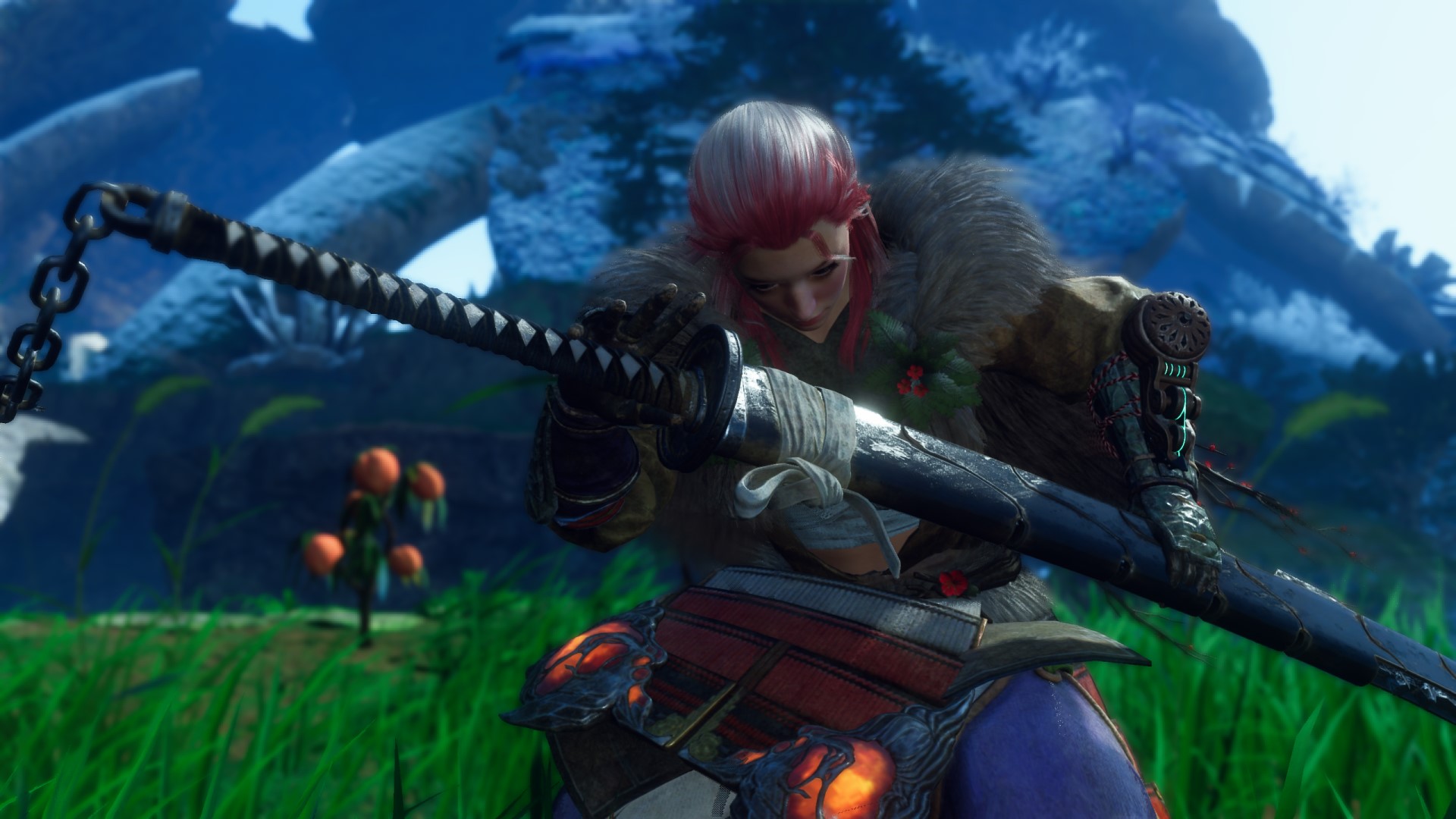
Strengths: Powerful, fast-striking unbound mode
Weaknesses: Damage relies on release gauge
The karakuri katana is your starting weapon in Wild Hearts, but that doesn't mean it's weak.
This weapon is equivalent to Monster Hunter's beloved longsword, but instead of building a spirit gauge to unleash devastating combos, you accumulate release gauge by attacking kemono. Potato, po-tato, but the name is a clue to what makes this katana different than you might expect. The best way to fill the release gauge is with the twin blade slash storm and iai slash burst combos. Once your release gauge is full, you can perform unbound attacks that deal significantly more damage while slowly draining the gauge.
Your basic unbound slashes turn the katana into a whip that strikes from a distance, but the most powerful unbound combo seems to be your iai slash burst. You perform this the same way as the original, but now its repeat stationary attacks deal a lot more damage. If you jump on three karakuri crates while unbound, you can also perform the katana's strongest attack: the unbound aerial twist drop, where you slash downwards for some serious DPS.
The katana is an appealingly simple weapon: you attack to get full release gauge, then unleash devastating unbound combos against kemono until it runs out or you deactivate it early. Its primary drawback is that you have to get full gauge before you can unleash proper DPS, but there are some katana-specific weapon skills that help with this. The Duel Master skill found on the Waxing Crescent Blade, for instance, boosts release gauge gains by 10%. Since the katana is also very stamina hungry, I'd recommend equipping armor pieces like the Grithide Loincloth that buff your overall amount.
Bladed Wagasa
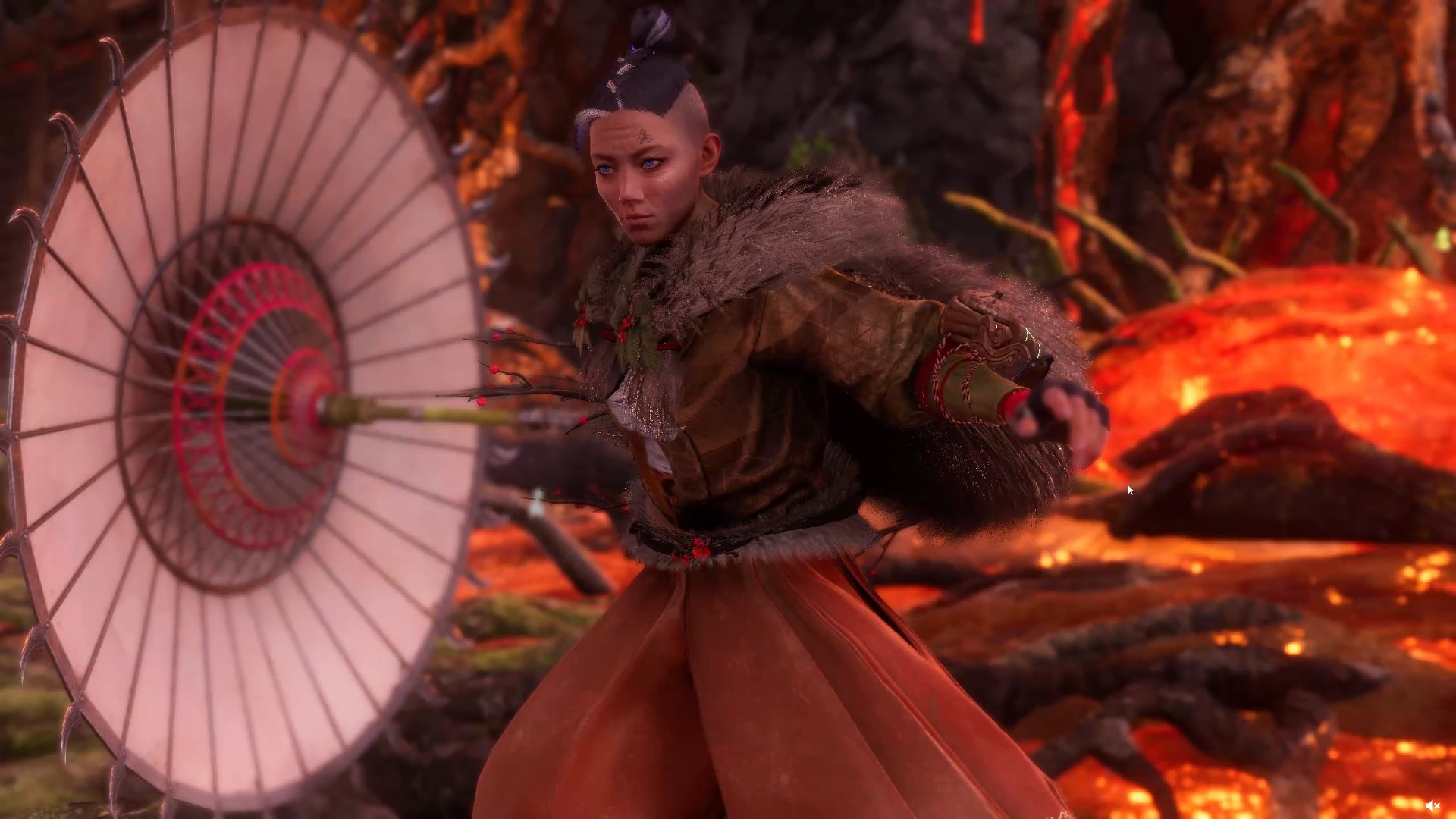
Strengths: The only Wild Hearts weapon with a parry
Weaknesses: Low damage unless you build up the parry meter
Ah, the killer umbrella—my first Wild Hearts love! The Bladed Wagasa bears the distinction of being the only weapon in Wild Hearts with defensive capabilities, but it's not always easy to use. The bladed wagasa is an umbrella you spin like a top to damage monsters, with a basic attack combo and a lunging move meant to help you close gaps. Parrying a kemono's attack with the wagasa will fill up roughly a third of your parry meter, and each tier you fill will kick your damage up a notch. When the meter's full, the wagasa glows like it's superheated and dishes out critical hits with each frenzied spin attack. It's a delight to use… assuming you can get it to that point.
The bladed wagasa's parry timing is tricky. It gives you a narrow window: even though the animation looks like you're opening the umbrella and preparing yourself for an oncoming attack, you don't want to press it too soon. Any lead time is likely to just get you smacked down hard. You need to press parry right as the kemono's attack is landing. Most of the kemono have a mix of fast and slow attacks, and some attacks that look like they're about to start that then trip you up with a delay. Those can be frustrating to deal with with the bladed wagasa, as mis-timing a parry burns some of your stamina meter and leaves you vulnerable to the hit.
Unless you live for parrying in action games, I'd recommend fighting a monster at least a couple times with other weapons before going up against them with the wagasa. Get a feel for how they move and attack before you commit your life to the parry button.
Maul
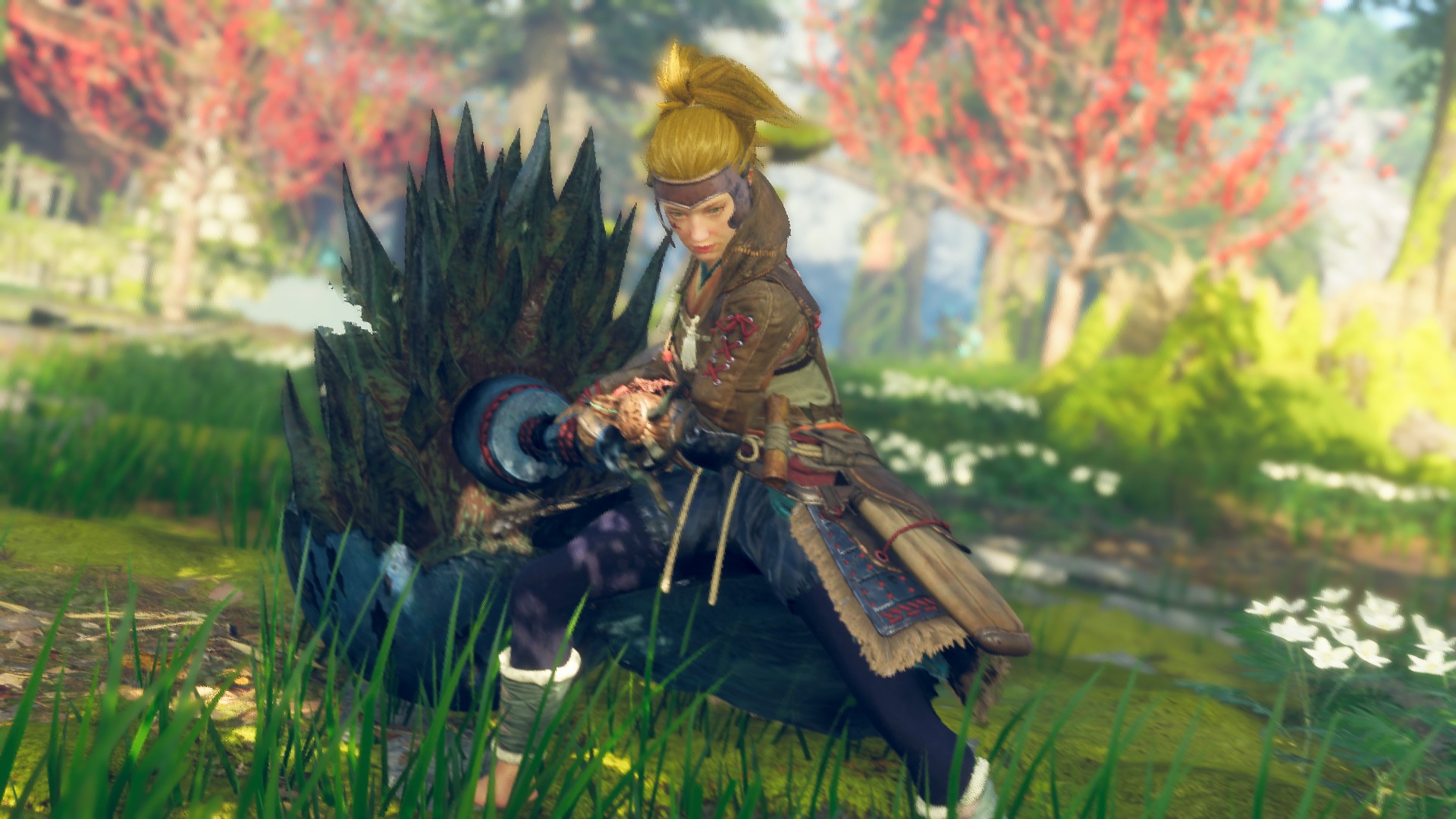
Strengths: Extremely high damage
Weaknesses: Slow to attack
Just like the slow-charging nodachi, the maul is capable of unleashing a massive amount of damage if your timing is good and you don't mind waiting for the opportune moment to strike. The maul is also unique in that its spinning power smash combo destroys basic karakuri, and launches them at monsters. If you used hammer in Monster Hunter, the key difference here is halve extension; essentially making the hammer haft longer as you combo, increasing its range and allowing for powerful finishing strikes.
The end goal here is those finishers, which while slow, deal an enormous amount of damage. You perform a finishing strike by using the power smash spin until the hammer haft extends fully, or you can get straight there by extending the haft during the basic combo, hitting F (or RT on controller) every time the hammer glows after an attack. This second method might be one of the most powerful combos in the game, letting you deal more damage than a fully charged nodachi attack, but with half the fuss.
Maul is a surprisingly mobile aerial weapon, too, and if you mix jumping smashes into your hammer haft extensions, you'll find yourself front-flipping over the kemono's head. In terms of weapon skills, I'd recommend the Helve Extension Training skill you get from the Freshet Maul, since this prevents reeling from attacks when using an extended maul, so you can more easily land those finishing moves without getting booped.
Claw Blade
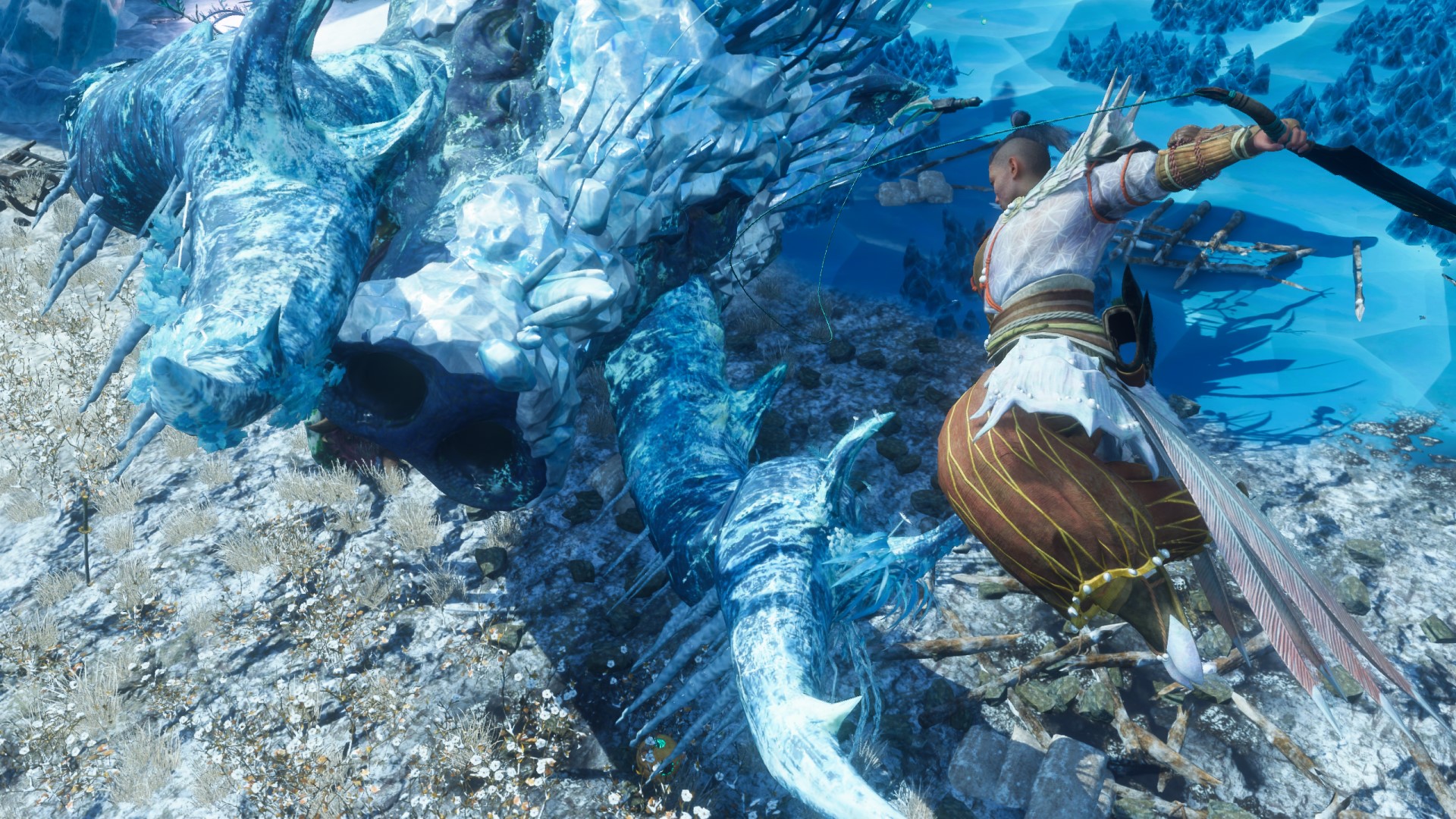
Strengths: Extremely high mobility, easy combos
Weaknesses: Mostly delivers lots of small hits rather than big charge attacks
The claw blade may be Wild Hearts' all-around best weapon—it certainly seems to be an early favorite in online play. The strength of the claw blade is its absurdly fast, flexible movement: after landing a quick flurry of hits on a kemono, you'll build up a charge meter that kicks in when you sink the blade into the monster's flesh. Once you're tethered, you use the rope attached to the claw blade to either hurl yourself at the monster for a series of spinning mid-air attacks, or use the dodge button to circle around them (also in mid-air).
These two moves make the claw blade supremely versatile: the dodge gives you enough range to get clear of just about any kemono attack, even when they're enraged, while the launcher attack gets you up close and personal at high speed, making you less likely to be hit when you deliver a quick strike. Once you've landed a few tethered combos, the claw blade allows you to land a big finish for critical damage. Time this when a kemono's winding up a big attack or in a vulnerable state, and you can even get a knockdown with it.
The claw blade's tethered form is a bit daunting at first, so practice on a weaker monster to get a feel for how to use it in the air and you'll be zipping around like an Attack on Titan character before long.
Nodachi
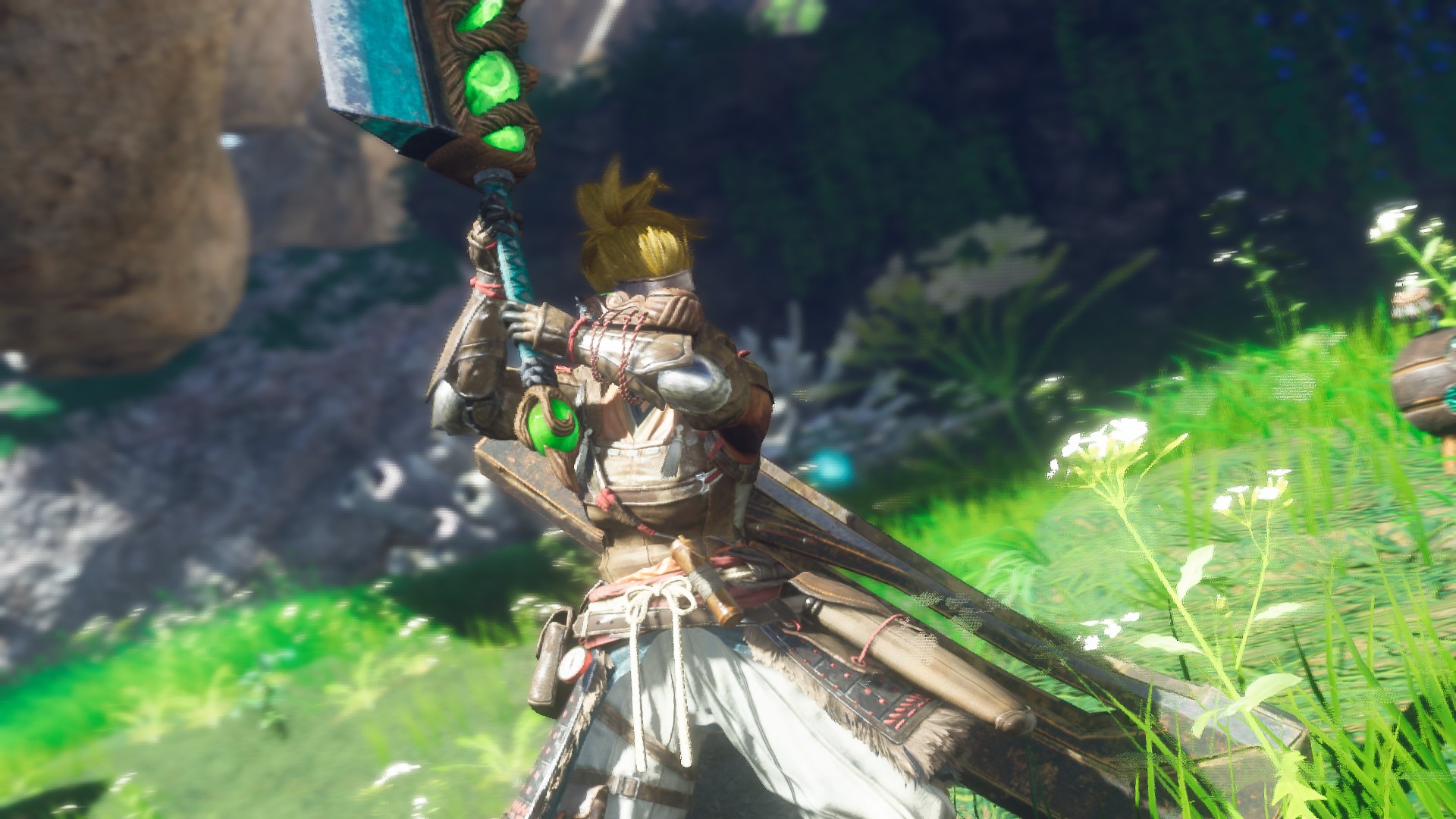
Strengths: Massive damage from charged attacks
Weaknesses: Stamina hungry and easy to get knocked out of charge
If you're a hunter who likes ending battles with a single decisive blow, the nodachi is your kind of weapon. Like the greatsword from Monster Hunter, its playstyle centers around charging up in your iai stance to perform powerful attacks capable of smashing parts off kemono or severing tails. There are three levels in the charging stance, and you gain charge faster by standing still, or by hitting kemono with attacks while in the stance. If you reach the max charge level, you perform a two-hit attack that's absolutely devastating if you land the second hit on a weak point.
The primary drawback with the nodachi is that iai stance drains stamina, and if you either run out or are hit by a kemono, you lose all of your charge. While you can dodge attacks during iai stance, this drains stamina, too, so it can put you in a bad spot. The best method is to time your attacks carefully, hitting the monster when it's distracted by your tsukomo companion or another player, or charging up before you enter the arena, so when the kemono comes running you can bash it in the face straight away.
Some of the more annoying aspects of the nodachi can be mitigated by skills. The Iai Art skill you get from the Waxing Crescent Nodachi reduces charged stamina consumption by 10%, which coupled with the Grithide Loincloth's 10% increase, can help a bit. The Steely Iai skill from the Yashima Nodachi also prevents reeling from attacks when readying a charge, which, as you'd imagine, is very handy.
Bow
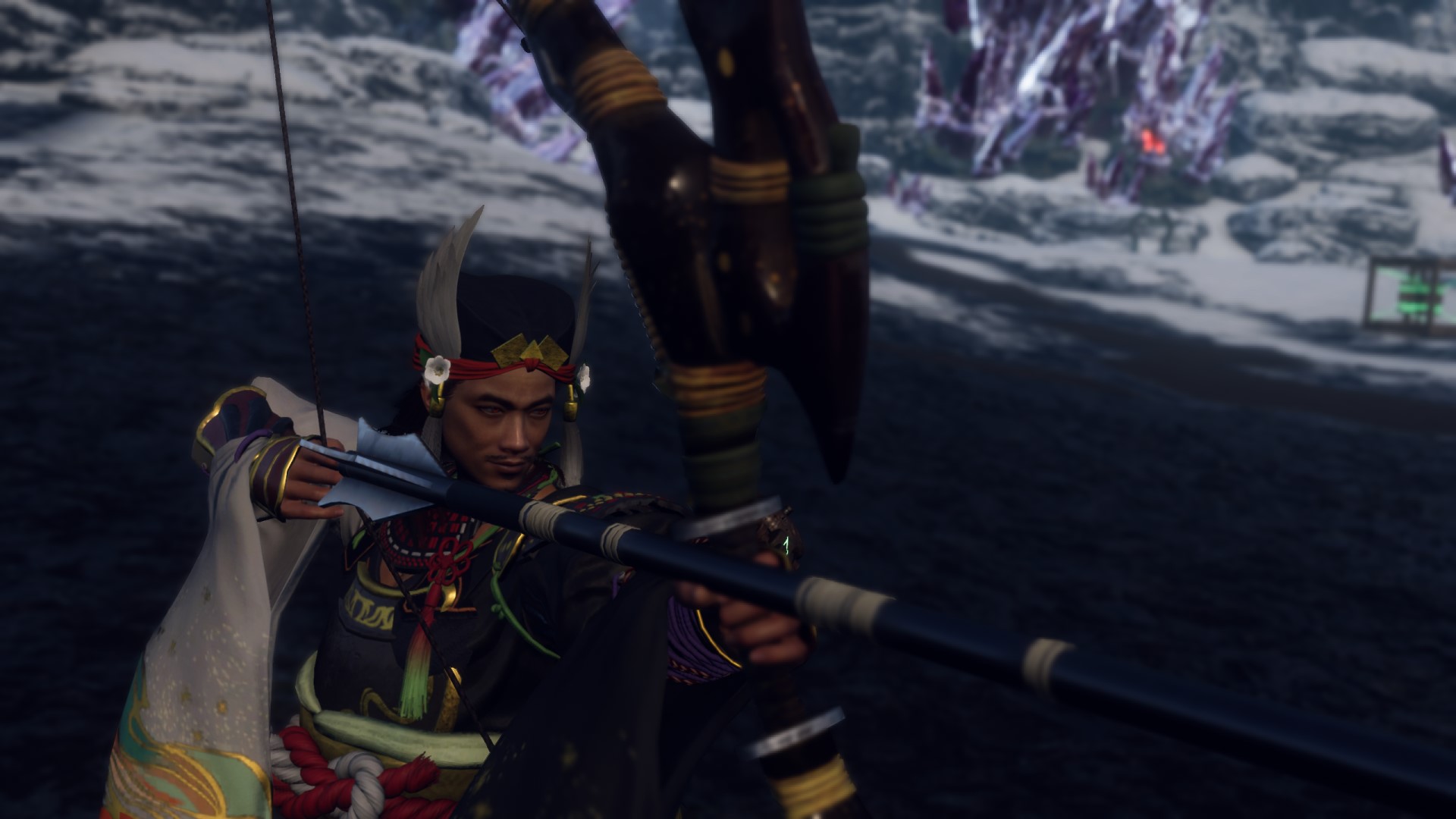
Wild Heart's bow is the best ranged option if you're playing by yourself, since it deals decent damage and allows you relative safety while keeping kemono at a distance. The bow fires two types of arrow: Haya and Otoya. The first peppers the kemono with shots that stick in place and glow green, while the second Otoya takes longer to charge but explodes the Haya arrows for extra damage on impact.
Bows also have two different bolstered stances, incrementally improving the damage of your charged Otoya shots. On the whole it creates a pretty straightforward gameplay loop: you pepper the kemono with Haya arrows, then bolster your bow to level two and fire a charged Otoya shot that resonates them all for decent damage. The only issue with bow is that using it can feel a little samey after a while.
In terms of weapon skills, I'd recommend the Able Archer skill you get from the Yashima Bow, since this increases the amount of Haya arrows you fire at the end of a combo, and so increases potential damage when you loose that Otoya shot to activate them all.
Hand Cannon
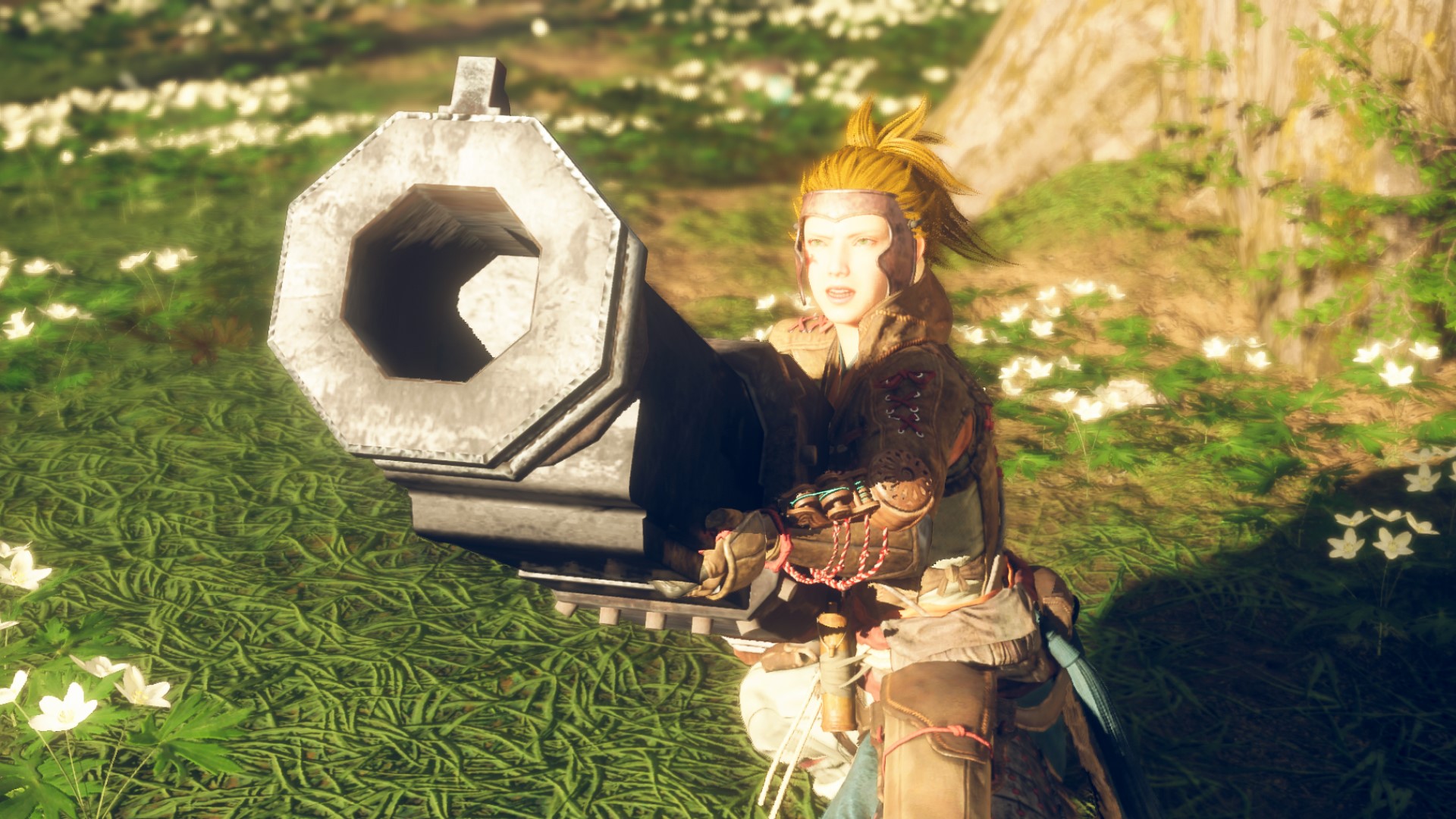
Strengths: Best attack fires a laser
Weaknesses: Slow movement and a bit fiddly
The Hand Cannon is a good support weapon if you're playing with other hunters, but honestly, it's kind of basic-feeling in comparison to Monster Hunter's bowguns. You fire repeat shots into kemono which increases your heat gauge, but you can also create a Ki Base that refills your charge when you stand in it so you don't run out of ammo. Simple so far, but where things get more complex is with Fortified Ki Bases.
When your heat gauge is red from firing, you can launch a Fortified Ki Base. This must hit a monster to activate, but when it does, you can draw from its power when standing in it and fire a damage-dealing laser that burns through your charge and ends in a big explosion. It's fun the first few times, but that's pretty much everything the weapon has to offer. In terms of skills I'd recommend Thread Thrift that you can get on the Freshet Cannon, since it reduces charge depletion so you can fire that laser longer. Speed Charge on the Waxing Crescent Cannon is also decent, since it increases charge fill rate so you can fire Fortified Ki Bases more often.
Karakuri Staff
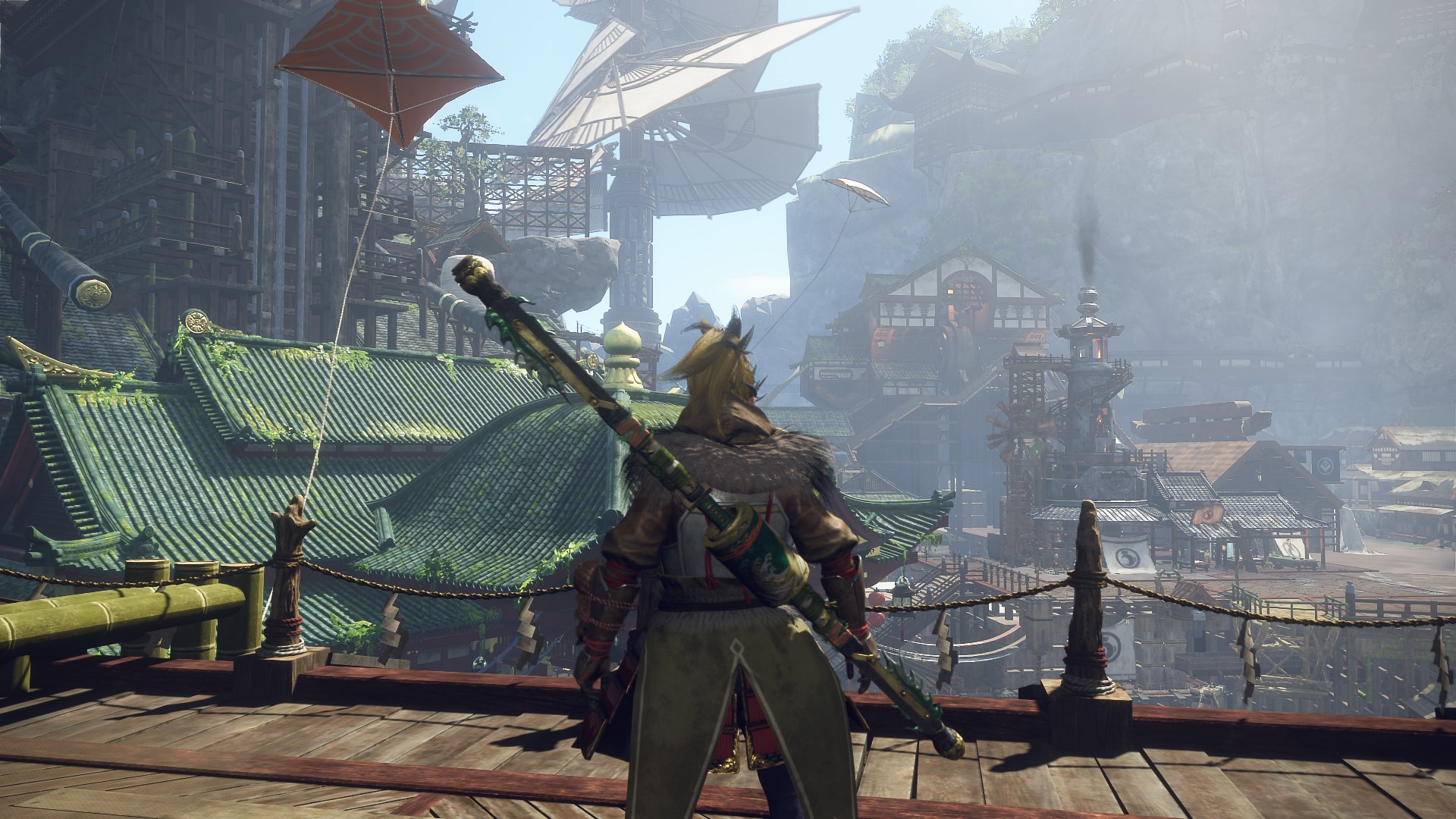
Strengths: Fight using five different weapons
Weaknesses: Fight using five different weapons
The Karakuri Staff is the most original weapon in Wild Hearts; a Bloodborne-esque trick weapon, but instead of one singular function, it transforms into five different weapons including a polearm, bladed tonfa, a big shuriken, and even a colossal greatsword. The Karakuri Staff is a tough weapon to master, partly because you have to remember how its different forms work, but also because its prolonged weapon swapping combos leave you open to getting smacked around by aggressive kemono.
The Karakuri Staff's central weapon mechanic is mutation levels, which increase as you land hits with its different forms, and successfully swap between them when they flash at the end of an attack or combo. Rather than using one weapon for a prolonged period, the staff is more about changing between them quickly to build levels, improving the power and speed of the juggernaut blade you can unleash. This attack is one of the most powerful in the game, especially if you jump on a crate before you do it, similar to the katana's unbound aerial twist drop.
While it's complex to master every weapon form, it has a simple playstyle: you attack with each form, mutating between them when they flash to build levels, then you unleash the juggernaut blade for massive damage. I'd recommend the Transformative Guard skill you can get from the Freshet Karakuri Staff, since this boosts defense by 16% when you mutate the weapon, which is when you're most vulnerable. The Combined Arts: Attack skill on the Yashima Karakuri Staff is also strong, buffing all power attacks by 10%.
How do Wild Hearts weapon skills work?
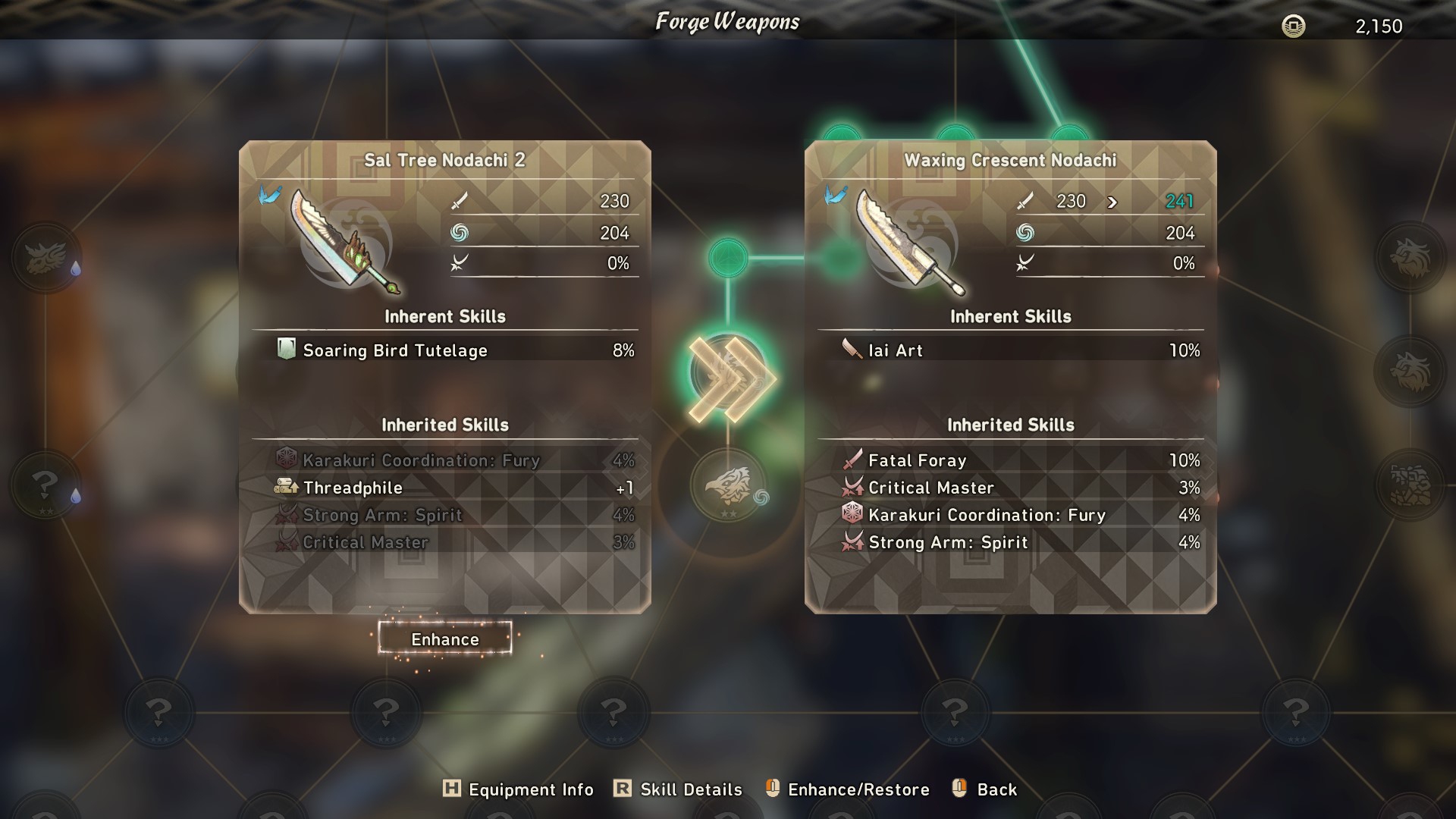
Each Wild Hearts weapon has both Inherent Skills and Inherited Skills. While the former is fixed and only changes when you upgrade a weapon, the latter is chosen by you, letting you bring forward skills you want to keep while discarding the others. As you progress further down the upgrade tree, weapons gain more Inherited Skill slots, allowing you to keep more skills from previous weapons.
This means that if you're looking for a particular skill combo, your chosen upgrade path is actually quite important in achieving it. You might not always choose to upgrade down a tree, but might upgrade horizontally as well to pick up a decent skill you want. That said, Inherent Skills are the most powerful, and include weapon-specific options.

Post a Comment